Aldebaran, also known as Alpha Taurus, is a captivating orange-colored star that shines brightly in the celestial sphere. Its luminosity has been observed by astronomers for thousands of years, dating back to 3000 B.C. This remarkable celestial body held immense significance in ancient cultures, such as Babylon, where its position marked the beginning of the year. However, it wasn’t until the 20th century that scientists discovered that Aldebaran is actually a binary star system, consisting of two bodies.
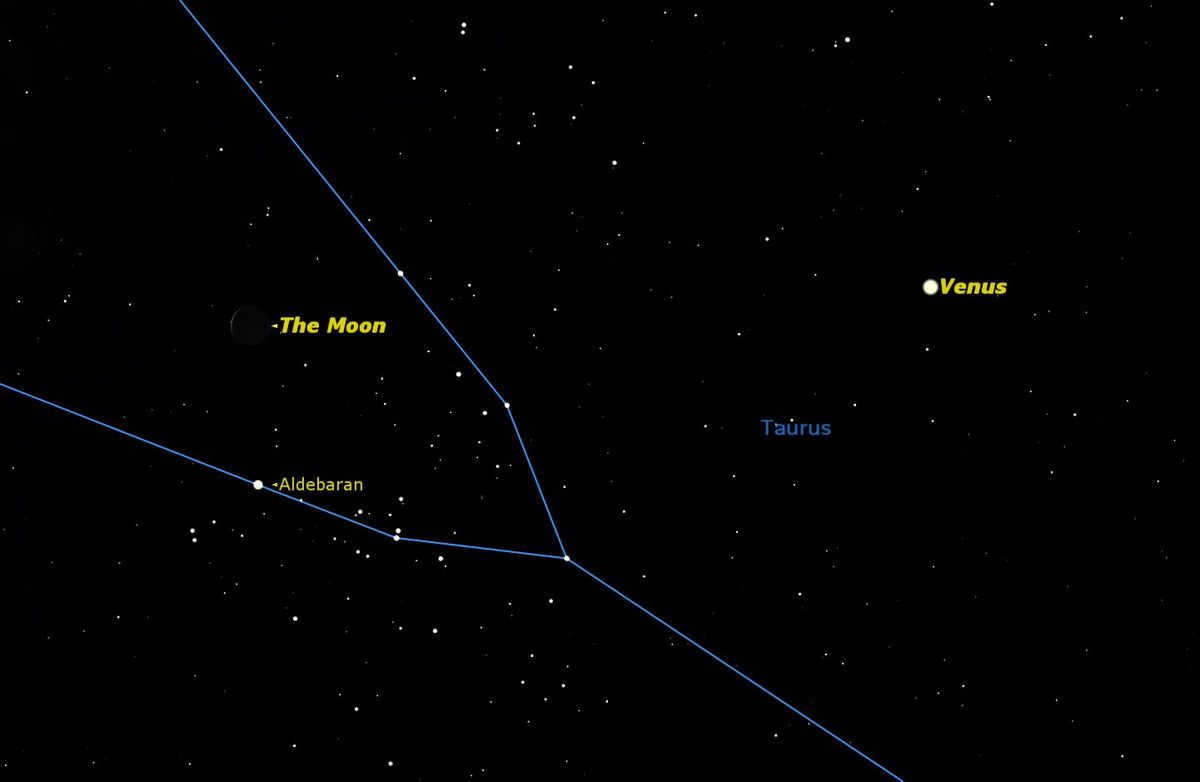
Aldebaran is a star that can be seen by the naked eye. Credit: starrynighteducation.com
Origin of the name
The name Aldebaran has Arabic roots and means “follower”. Although the star was given this name in ancient times, it was officially recognized by the International Astronomical Union only in 2016.
When observing the night sky, one may notice that Aldebaran appears to be constantly following the Pleiades cluster. This observation played a role in the star’s naming.
Other ancient civilizations referred to this celestial body as the Eye and Heart of the Bull, as well as the Torch, the Eye of God, and the Star of Illumination.
Important Details
Aldebaran is positioned at the 14th spot when it comes to the brightest stars that can be seen from Earth. This specific celestial entity is located at a distance of 65 light-years away from our Solar System and is continuously drifting away at a velocity of 53.8 km/s.
Aldebaran is classified as an LB variable star. This classification implies that its brightness fluctuates irregularly and with a small range of variation.
The age of this celestial object is estimated to be over 6.5 billion years. All the hydrogen that comprised the star has been already recycled. The thermonuclear reactions are now being powered by helium. It is predicted that the star will only survive for another 2 billion years. Once its fuel reserves are depleted, Aldebaran will undergo a supernova explosion, eventually transforming into a white dwarf.
The star system of Aldebaran
Aldebaran consists of two stars.
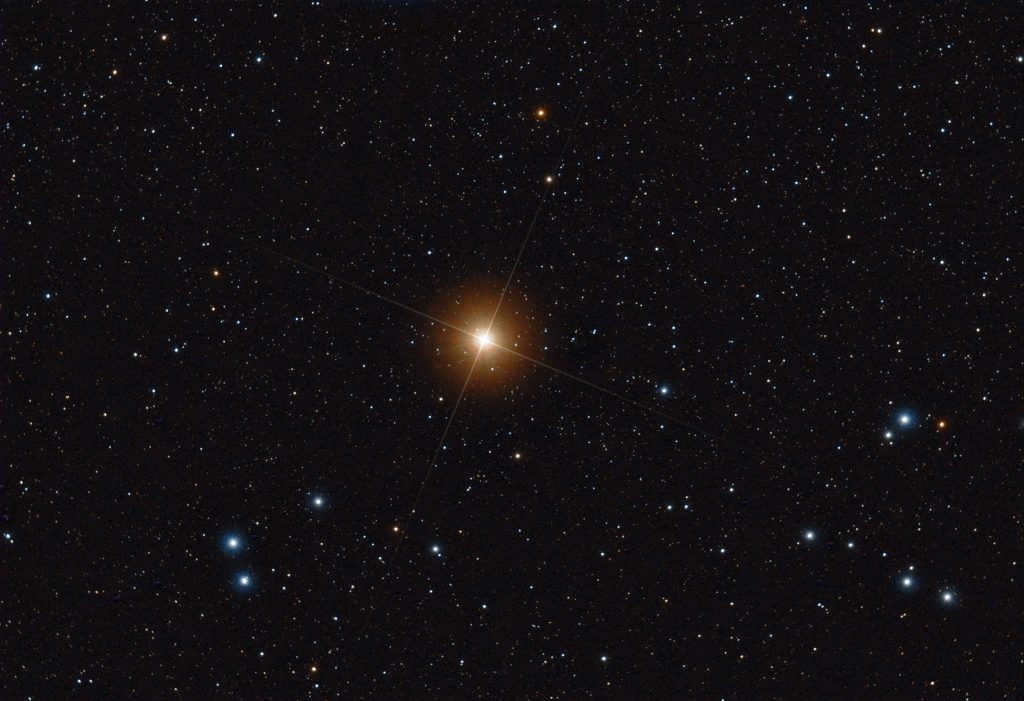
- Contrary to popular belief, the Aldebaran system is not a supergiant, but is actually classified as a normal giant with a luminosity of spectral class K5 III that can be seen from Earth;
- There is also a red dwarf in the Aldebaran system, which is several hundred astronomical units away and belongs to the spectral class M2V.
In addition to these two main stars, the Aldebaran system has 3 optical companions. Two of these companions form another double star system and are classified as dwarf and subdwarf objects. These objects are part of the Hyades cluster and are located 70 light years away from the Aldebaran system.
One of the closest objects to the Aldebaran system is a star known as VA 366. It is located at a distance of only 41.6 trillion kilometers.
Physical attributes
Aldebaran A surpasses the Sun in significant physical characteristics:
- with a mass that is 2.5 times greater (according to other scientists, it is only 1.3 times greater);
- with a radius that is 43 times larger;
- with a luminosity that is 150 times greater.

These are the physical attributes of Aldebaran:
- It has a temperature of up to 3875 K.
- Its rotational velocity is 4.3 kilometers per second.
- The absolute stellar magnitude is -0.63.
- The apparent magnitude ranges from 0.75 to 0.95.
During its normal sequence, it is believed that Aldebaran was classified as a star of spectral class F7.
Aldebaran is part of the Taurus constellation. To locate this star in the sky of the Northern Hemisphere, you can extend the line of Orion’s belt to the right and upwards. Another method of identification is to search for the Hyades cluster. When observed from Earth, it seems to be situated at the apex of one of the horns in the V-shaped pattern.
In terms of equatorial coordinates, this celestial object can be found at the following positions on a celestial sphere map:
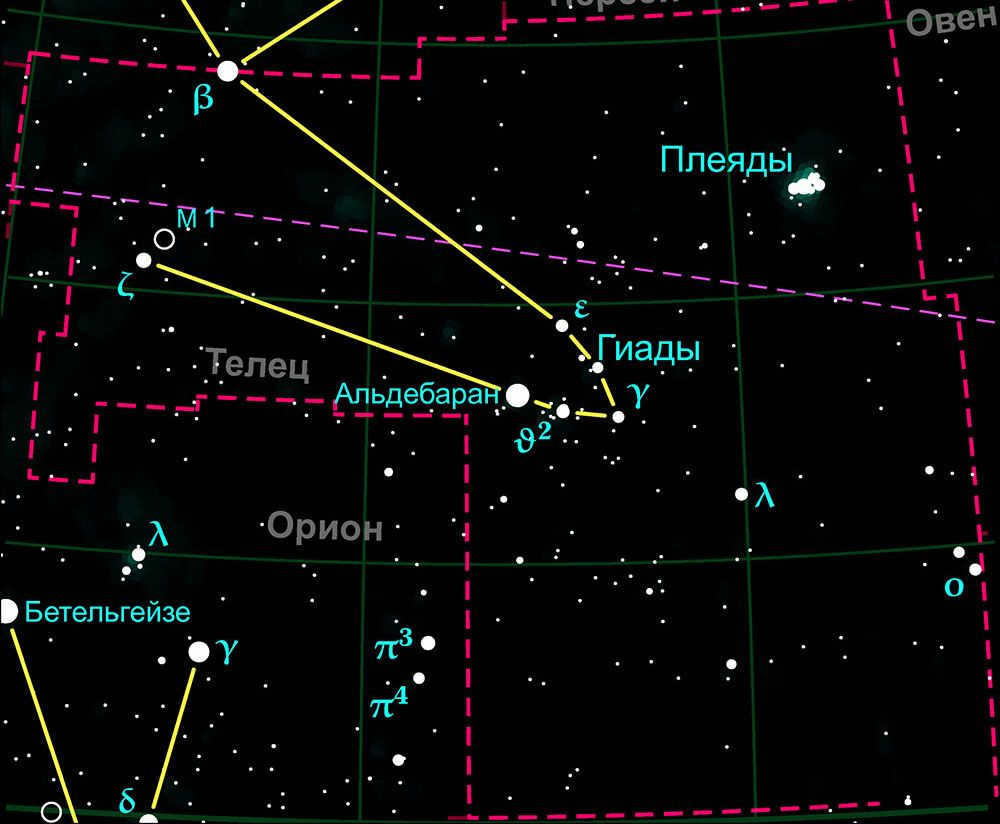
Optimal time for observing
The most favorable period for observing the star Alpha Taurus is during the winter season. However, it is important to note that in the month of December, the planet Jupiter passes through this celestial constellation, creating a potential risk of mistakenly identifying this prominent and luminous object as Aldebaran.
Furthermore, it is worth mentioning that this celestial body is also a part of the Winter Circle asterism, which is particularly well-visible from the equatorial regions.
Unbelievable Trivia
During the early 1970s, an incredible endeavor was undertaken by the Soviet Union with the launch of the Pioneer-10 unmanned spacecraft. This groundbreaking spacecraft is currently soaring towards the distant star, Aldebaran, with an estimated arrival time of 2 million years. Remarkably, the spacecraft carries a collection of records that divulge crucial details about the solar system’s composition and even provide descriptions of various forms of life on Earth.
Interestingly, the Hipparchus satellite, which orbited our planet from 1989 to 1992, played a vital role in uncovering key information about this captivating star. Utilizing advanced technology, this satellite was able to accurately determine the exact distance to Aldebaran, further expanding our knowledge of the cosmos.
In 1993, research was conducted on the orbit of this celestial object, leading to the hypothesis that a sub-stellar object called Aldebaran ab could be located at a distance of approximately 1.35 astronomical units from it. This sub-stellar object could potentially be a gas giant or a brown dwarf, with a mass 11.5 times that of Jupiter.
In 2015, scientists announced the discovery of a possible candidate for Aldebaran ab. However, in 2019, researchers from the Lick Observatory, situated near San Jose, California, contradicted these findings. Therefore, the question of whether planets exist in this star system remains unanswered.
One of the most intriguing optical phenomena associated with Aldebaran is its occultation by the Moon. This event occurs multiple times throughout the year and can even be observed during daylight hours.
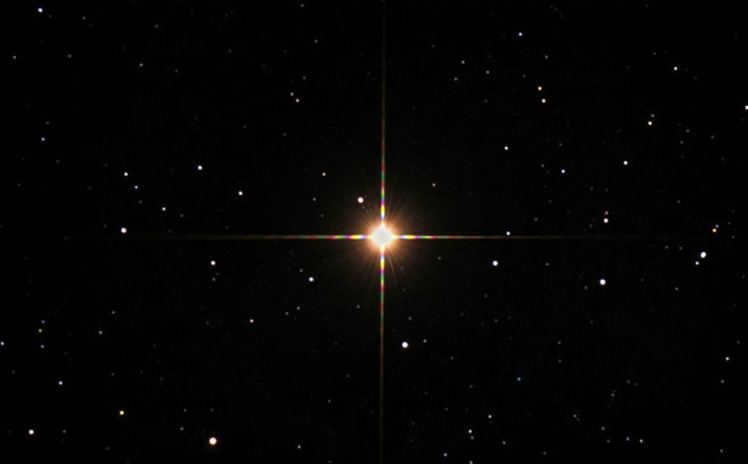
When we observe Aldebaran from our planet, it appears to be connected to the Hyades star cluster, which is easily visible in the Taurus constellation without the need for any special equipment.
Overview
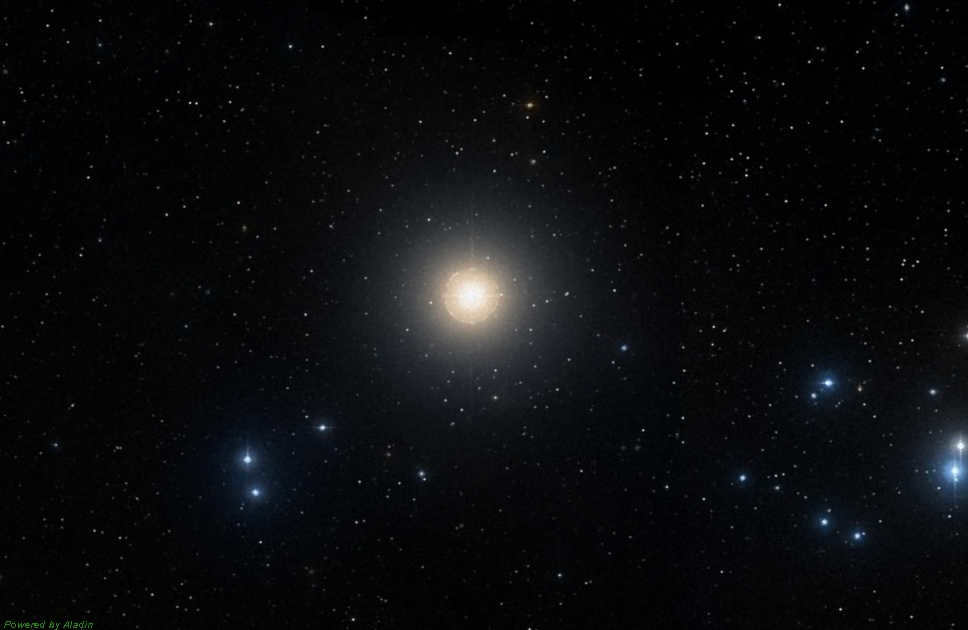
An image of the Aldebaran star captured from the DSS catalog
Four stars are held together by the force of gravity in the Hyades.
Additional Resources
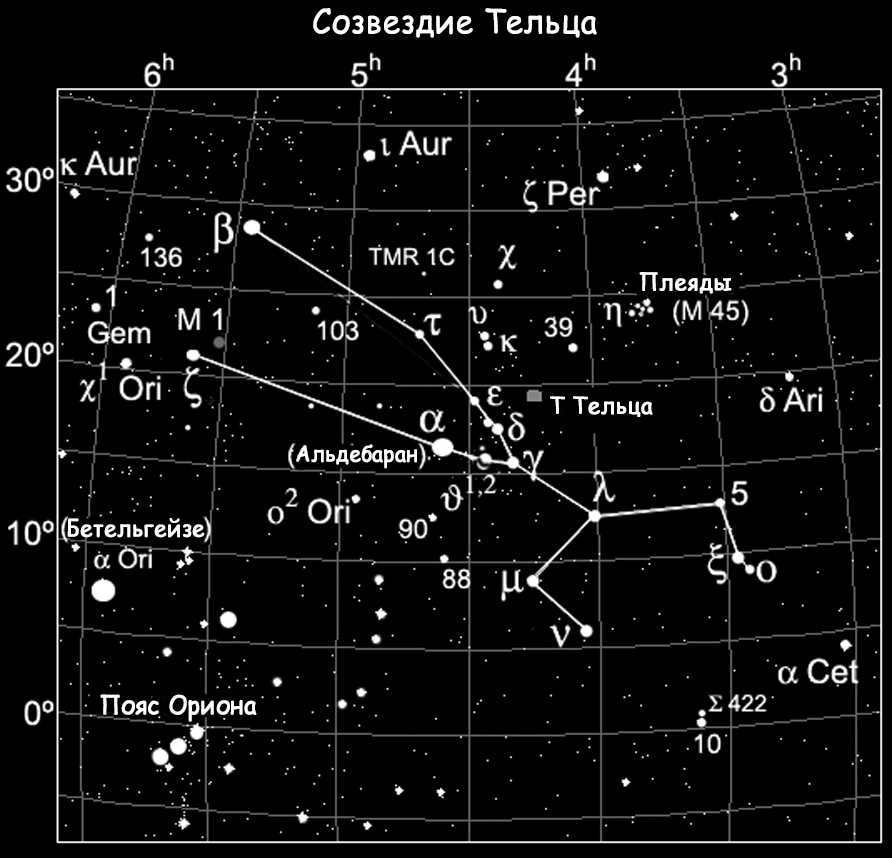
Aldebaran and the Hyades together create a formation that resembles an English V, giving the impression of a cohesive unit. However, in reality, Aldebaran stands alone in the vast expanse of the universe. Its closest neighbors, apart from its personal companion, are located at a considerable distance of 20 light years.
Revolving around Aldebaran is a small companion in the form of a red dwarf. This companion emits such a faint light that it cannot be observed without specialized equipment.
Astronomers have hypothesized the existence of a large planet in orbit around Aldebaran. This planet is believed to have a mass equivalent to 11 Jupiters and is situated at a distance of 1.35 astronomical units from the star. However, further evidence is still required to confirm this theory.
Origin of the name
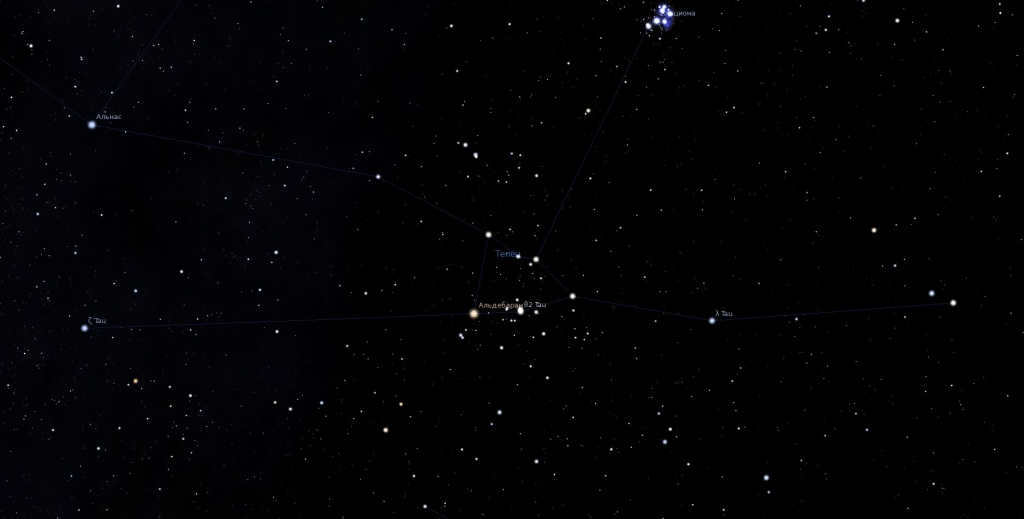

A perspective of the star in the planetarium software
The Arabs named the star and it translates to “follower” or “following…”
Similar to other prominent stars, Aldebaran possesses multiple names: The Eye of Taurus or “Bull’s Eye” indicates its position within the constellation. Palilius is the name used in Roman culture. Lamparus is the Greek name and signifies the “torch” or “beacon” of the night sky.
The ancient Persians held the star in high regard, assigning it a royal status. Its existence was known as far back as 3000 BC.
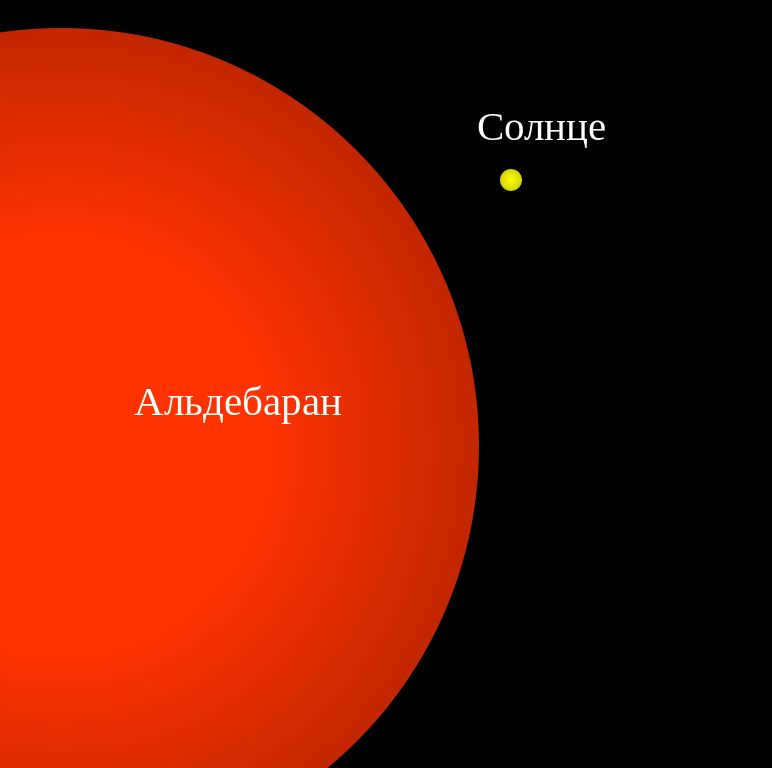
Comparison between the Sun and Aldebaran in terms of size
Aldebaran is classified as a typical giant star with a spectral class of K5 III. It emits a radiant orange light and has a diameter of approximately 61 million kilometers.
Based on observations, scientists speculate that Aldebaran has depleted its hydrogen fuel and is now undergoing helium fusion. As a result, the star has expanded in size and its temperature has increased due to gravitational pressure.
Aldebaran is located about 65 light years away from Earth. It is estimated to be 150 times more luminous and 44 times larger than the Sun. Its luminosity ranks it as the fourteenth brightest star.
Location in the heavens
Firstly, it is imperative to locate the prominent constellation Orion. From there, veer to the right of its belt in a direct path. The initial luminous beacon will be the star Aldebaran.
Optimal observation time
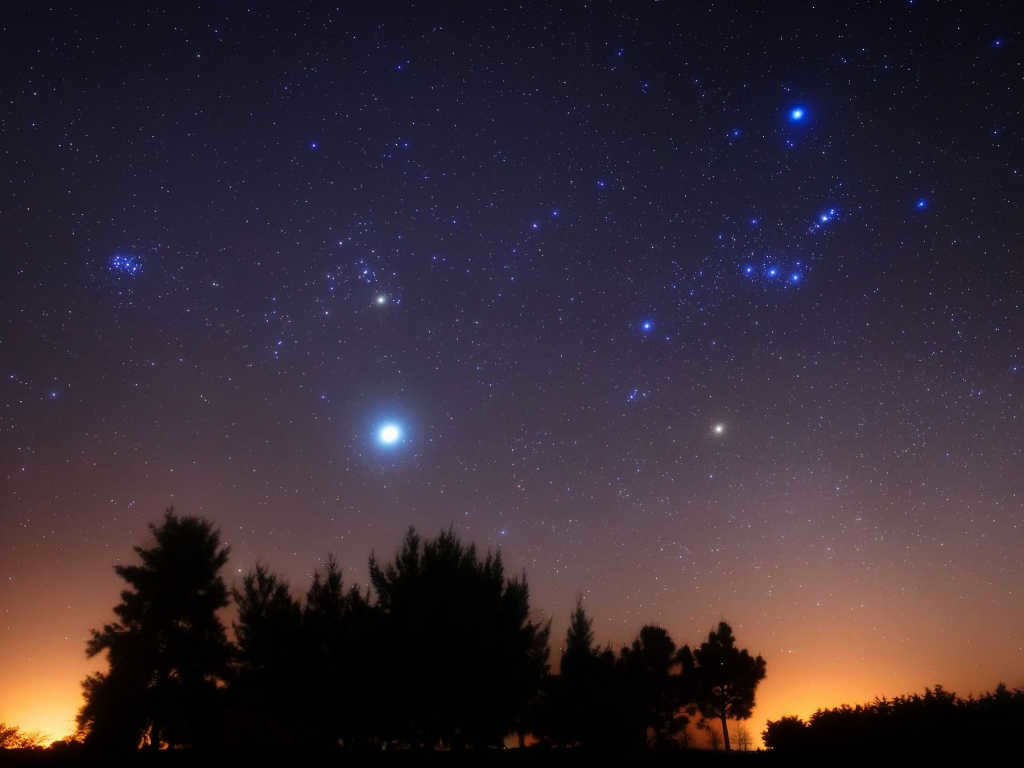
During the winter months, Aldebaran can be observed alongside Jupiter, Betelgeuse, M42, and the Pleiades. Jupiter passes through the constellation of Taurus in December, making it an ideal time to catch a glimpse of Aldebaran. However, it’s important to note that Jupiter is much larger and brighter than Aldebaran, so it may outshine the star.
Engaging Trivia

In the early 1970s, the Pioneer-10 spacecraft was launched, embarking on a journey beyond the solar system towards the star Aldebaran. Accompanying it is a message containing a simple depiction of life on Earth and the composition of our solar system. It is estimated to reach its destination in approximately 2 million years. The last communication from Pioneer 10 was received by Earth a decade ago.
A significant amount of information about Aldebaran has been derived from the American satellite Hipparcos. It operated in space for a duration of 37 months starting in 1989. The Hipparcos satellite accurately determined the distance between the Sun and Aldebaran to the best of its capabilities.
Compilation of the most luminous stars
| 0 | Sun | 0.0000158 | −26.72 | 4.8 | G2V | |
| 1 | Sirius (α of the Big Dog) | 8.6 | −1.46 | 1.4 | A1Vm | Southern |
| 2 | Canopus (α of Kiel) | 310 | −0.72 | −5.53 | A9II | South |
| 3 | Toliman (α Centauri) | 4.3 | −0.27 | 4.06 | G2V+K1V | South |
| 4 | Arcturus (α Volopas) | 34 | −0.04 | −0.3 | K1.5IIIp | North |
| 5 | Vega (α Lyra) | 25 | 0.03 (alternating) | 0.6 | A0Va | Northern |
| 6 | Capella (α of Ascendant) | 41 | 0.08 | −0.5 | G6III + G2III | North |
| 7 | Rigel (β Orion) | ~870 | 0.12 (perm) | −7 | B8Iae | South |
| 8 | Procyon (α of the Lesser Dog) | 11.4 | 0.38 | 2.6 | F5IV-V | North |
| 9 | Ahernar (α Eridanus) | 69 | 0.46 | −1.3 | B3Vnp | South |
| 10 | Betelgeuse (α Orion) | ~530 | 0.50 (perm) | −5.14 | M2Iab | North |
| 11 | Hadar (β Centauri) | ~400 | 0.61 (perm) | −4.4 | B1III | South |
| 12 | Altair (α Eagle) | 16 | 0.77 | 2.3 | A7Vn | Northern |
| 13 | Acrux (α of the Southern Cross) | ~330 | 0.79 | −4.6 | B0.5Iv + B1Vn | South |
| 14 | Aldebaran (α Taurus) | 60 | 0.85 (rem) | −0.3 | K5III | North |
| 15 | Antares (α Scorpio) | ~610 | 0.96 (perm) | −5.2 | M1.5Iab | South |
| 16 | Spica (α Virgo) | 250 | 0.98 (perm) | −3.2 | B1V | Southern |
| 17 | Pollux (β Gemini) | 40 | 1.14 | 0.7 | K0IIIb | Northern |
| 18 | Fomalgaut (α of South Pisces) | 22 | 1.16 | 2.0 | A3Va | Southern |
| 19 | Mimosa (β of Southern Cross) | ~290 | 1.25 (perm) | −4.7 | B0.5III | Southern |
| 20 | Deneb (α of the Swan) | ~1550 | 1.25 | −7.2 | A2Ia | Northern |
| 21 | Regulus (α Leo) | 69 | 1.35 | −0.3 | B7Vn | Northern |
| 22 | Adara (ε of the Great Dog) | ~400 | 1.50 | −4.8 | B2II | South |
| 23 | Castor (α Gemini) | 49 | 1.57 | 0.5 | A1V + A2V | Northern |
| 24 | Hakrux (γ Southern Cross) | 120 | 1.63 (perm) | −1.2 | M3.5III | South |
| 25 | Shaula (λ of Scorpio) | 330 | 1.63 (perm) | −3.5 | B1.5IV | Southern |
This post was published on 11/28/2014
Author: Maxim Zabolotsky
Aldebaran, a solitary star, stands out among the numerous shining points in the dark night sky, captivating the attention of humans for over 3,000 years. References to this celestial body can be found in fantasy literature, and it has also made appearances in movies. Enthusiasts of astronomy are fascinated by anything related to this brilliant star.
Overview
The general knowledge about Aldebaran indicates that it has been in existence for billions of years. Throughout this extensive timeframe, the former red celestial body has undergone significant changes in its spectral appearance. Currently, Aldebaran emits an orange hue, which classifies it as a K5III type star and places it among the category of normal giants. Notably, the star demonstrates a minimal light amplitude, indicating a relative level of variability.
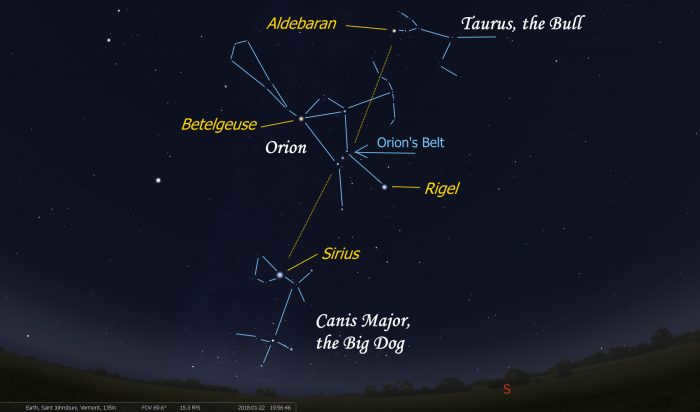

Throughout its existence, the planet has managed to consume all the hydrogen in its core and has now transitioned to burning helium instead.
These processes have resulted in an expansion of the object’s size and temperature, causing a change in the appearance of the star. The primary component of the outer layer (as per the latest findings) has expanded to approximately 38 times the diameter of the Sun.
In a few more epochs, the helium in its atmosphere will be depleted, transforming the planet into a white dwarf.
Currently, Aldebaran is a supergiant star with a diameter 44 times larger than that of the Sun.
The visibility of the planet is due to its relatively close distance from Earth, which is only 65 light years away.
If you gaze at the night sky, it appears that Aldebaran is a member of the Hyades group, forming a “V” shape with four of them. According to astrological records, this star is classified as part of the Taurus constellation, symbolizing its eye.
However, this is merely an optical illusion. While the stars of the Hyades are bound together by gravitational attraction, Aldebaran stands alone, seemingly “projected” onto the cluster. Its closest neighbors are situated 20 light-years away.
The illusion is further supported by cosmic distances. Aldebaran is positioned twice as close to the Sun compared to the Hyades. The star cluster itself is about 135 light-years away from Earth.
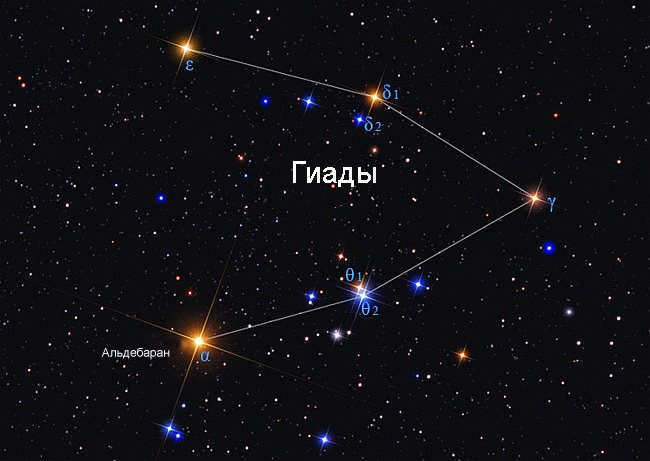

Origin of the name
The name Aldebaran originates from Arabic and means “follower”. While this name has been associated with the star since ancient times, it was officially approved by the International Astronomical Union in 2016.
When observing the night sky, Aldebaran appears to be constantly following the Pleiades cluster. In ancient times, it was referred to as the Eye and Heart of the Bull, as well as the Torch, the Eye of God, and the Star of Illumination.
Aldebaran, the left eye of Taurus, is known as a representation of prosperity. The right eye of Taurus remains hidden from our view and represents the ethereal aspect of humanity. Aldebaran is also referred to as the Protector of the East. It possesses immense strength and is closely linked to the attainment of desires. Its vibrant scarlet hue reflects the influence of Mars. The alignment of Aldebaran with planets in one’s horoscope holds great significance, as does the positioning of other Royal Stars.
Aldebaran has the ability to grant wealth, but it is crucial to remain aware of a potential pitfall that can be challenging to avoid. When striving for wealth and success, it is easy to overlook one’s spiritual well-being. Being situated in the constellation of Taurus, Aldebaran focuses on the journey through material possessions, overcoming temptations, and seeking self-awareness. This star holds significance in both individual birth charts and national horoscopes, symbolizing new beginnings and fresh starts.
Aldebaran embodies a potent energy of allure and charm. Individuals with a strong presence of this star in their horoscope possess magnetic qualities and the ability to draw others towards them. Aldebaran instills determination, enabling the person to achieve their goals no matter the cost.
At the lowest point, an individual showcases foolish obstinacy and indulges in their own cravings. At the utmost stage of growth, spiritual enlightenment takes place, giving rise to the potential for foresight and revealing the hidden significance of occurrences. Indeed, Aldebaran serves as the divine gaze of the Bull-Zeus, acting as God’s own Eye.
Origin and Background of the Name
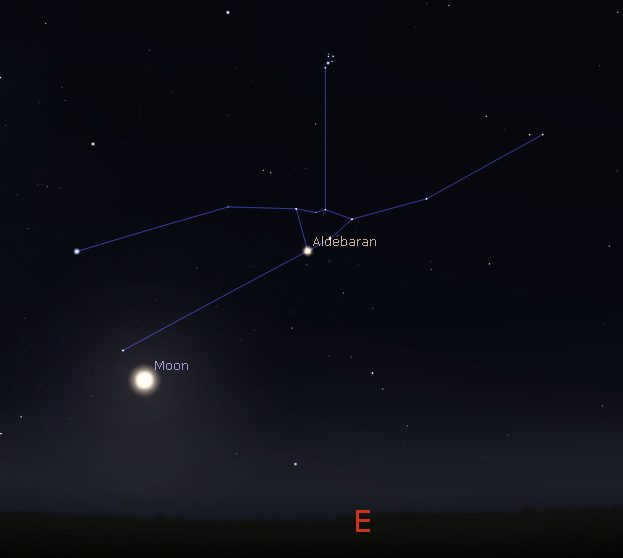

References to the star Aldebaran can be found in ancient texts of various civilizations, resulting in the star having multiple names. The Greeks referred to this bright celestial object as “Lamparus”, meaning “lighthouse” or “torch”, as described by Claudius Ptolemy. This name highlights the star’s luminosity in the darkness of the night sky.
The Romans, on the other hand, commonly referred to the star as “Palilicium” in celebration of the equinox festival known as Pales. The Persians regarded it as the “Royal Star” or “Tusketeer”, while the ancient Chinese called it the “Heart of the Bull”.
The Bulgarian people have a different association for Aldebaran compared to the rest of the world. They refer to it as “Bagpiper” and consider it to be part of the star cluster known as “Chorovod”.
The origin of the name, recognized by scientists as official, can be traced back to Arabic. In Arabic, it means “follower” as it is seen following the Pleiades. The Pleiades is a large scattered cluster in the sky, but only 7 stars are visible to the naked eye.
In the early 17th century, Aldebaran was given the designation “Alpha Taurus” by Johann Bayer, a German astronomer, in his stellar treatise “Uranometria”. This name specifically refers to the brightest planet in the constellation of Taurus.
Which constellation does Aldebaran belong to?
Aldebaran actually belongs to the Taurus constellation. It is known as the Alpha star in this part of the sky and is one of the brightest stars in the zodiac, if not the entire sky. Its name is derived from Arabic and means “follower,” likely because it appears to move directly behind the Pleiades. Some people also refer to Aldebaran as the Eye of Taurus, as it resembles the eyes of a bull. It is also known by other names such as Palilius or Lamparus.


Aldebaran’s Size
Characteristics of the star
The star’s description provides information that helps identify its position in scientific databases. Based on its spectral class, the orange giant is classified as K5 III. The main parameters of the star are listed in the table.
Characteristics of α Taurus
| Parameters | Unit. | Indicator (average) |
| Mass of the planet | M☉* | 2.5 |
| Radius | R☉ | 43 |
| Age | billion years | 6.6±2.4 |
| Metallicity** | % | 70 |
| Temperature | K | 3875-3050 |
| Luminosity | L☉ | 150 |
*Luminosity is a unit of measurement that estimates the parameters of stars relative to the Sun (M, R, L).
**The term defines the presence on a planet of chemical elements that are heavier than helium and hydrogen by mass. The indicator is taken as a percentage of the solar parameter
Parallax is an important factor in astrometry, as it measures the angle of displacement of an object relative to the observer’s location. In the case of Aldebaran, the parallax is measured at 50.09 mas (milliseconds), providing a highly accurate measurement of the star’s distance. Additionally, the planet has a radial velocity of 53.8 km/s.
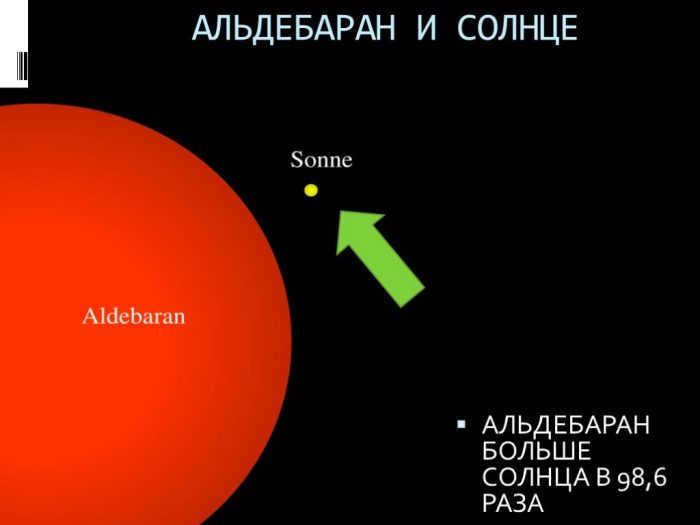
Aldebaran A is a giant star with an orange color. Its brightness changes slightly due to ongoing processes, which classifies it as an irregular type of variable star.
Compared to our Sun, Aldebaran A is larger with a radius 43 times bigger and a mass 2.5 times heavier. Its luminosity is also 150 times greater than that of the Sun, making it the fourteenth brightest star. The temperature of Aldebaran A can reach up to 4000 K. It is located 65 light-years away from us, and it would take the Pioneer 10 drone, which was launched in 1972, around two million years to reach it. The vastness of the Universe is truly mind-boggling!
Aldebaran B is the companion star of Aldebaran A, located a few hundred astronomical units away. It is a red dwarf star with a radius and mass approximately 0.44 times that of the Sun. Its luminosity is only 0.035 times that of the Sun, and its temperature is around 3600 K. Stars of this class are still not fully understood by scientists.
There is another member called Aldebaran A b that has been discovered quite recently. Based on initial data, this exoplanet is slightly smaller in size compared to Jupiter. It has a mass that is 6.47 times greater and orbits around Aldebaran in 629 days, at a distance of 218,412,892 kilometers.


Characteristics of the star Aldebaran
Locating Aldebaran
The optimal time for observing Aldebaran is during the winter and spring seasons. To easily locate it, one can start by identifying the three stars in Orion’s belt and then draw a straight line to the right. The brightest star encountered along this line, which has a reddish-orange hue, will be Aldebaran. Aldebaran is the alpha star of the Taurus constellation. Within the constellation, there are two clusters known as the Pleiades and the Hyades. When observing from Earth, it may appear that Aldebaran is part of the Hyades cluster, which is characterized by a V shape formed by its bright stars. However, this is actually an optical illusion, as the cluster is located 153 light years away, much farther from us than Aldebaran.
Visual counterparts
Close to Aldebaran, there are five faint stars that can be seen in the sky. These stars are actually pairs of stars, and they have been given capital letters from the Latin alphabet to represent them. The letters are assigned in the approximate order of their discovery, with the letter A being used for the main star. Some information about these star pairs, such as their position in relation to Aldebaran, is provided in the table.
According to research like the Gaia Data Release 2, it has been suggested that Alpha Taurus B and Aldebaran have similar proper motion and parallax, indicating that they may be a binary system. However, due to the close proximity of the faint B component to the bright host star, it is challenging to make accurate measurements, and there is still a significant margin of error. As a result, it is currently uncertain whether there is a physical connection between the two. Thus far, there is no conclusive evidence linking the B component or anything else to Aldebaran. The B component has been assigned a spectral class of M2.5.
Planetary system
In 1993, the radial velocity measurements of Aldebaran, Arcturus, and Pollux indicated that Aldebaran displays long-term fluctuations in radial velocity that may be interpreted as the presence of a sub-stellar companion. The measurements for Aldebaran implied the existence of a companion with a minimum mass 11.4 times that of Jupiter, orbiting every 643 days at a distance of 2.0 a.u. (300 Gm) in a slightly eccentric orbit. However, all three stars examined exhibited similar oscillations and yielded similar companion masses, leading the authors to conclude that the observed changes were likely intrinsic to the stars themselves and not a result of a gravitational effect caused by a companion.
In the year 2015, a study was conducted which presented consistent and enduring evidence supporting the existence of both a planetary companion and stellar activity. Through the use of asteroseismic analysis, it was determined that the remnants found on the planet’s accretion indicate that Aldebaran b possesses a minimum mass of 5.8 ± 0.7 Jupiter masses. Furthermore, it was discovered that when the star was in its main sequence phase, it emitted light levels comparable to those of Earth, thus suggesting a potentially habitable temperature range. As a result, it can be inferred that both Aldebaran b and any accompanying satellites reside within the habitable zone.
Etymology and mythology
Aldebaran was initially known as نير الضبران (Nā᾽ir al Dabarān in Arabic), which translates to “bright of the follower”. The term al Dabarān (الدبران) was later used to refer to the entire lunar mansion that includes the Hyades. It is believed that Aldebaran was following the Pleiades. Different transliteration spellings have been used, but the current standard is Aldebaran.
Mythology
This well-known and vibrant star, with its evocative constellation, is a popular topic in ancient and contemporary legends.
- Mexican culture: According to the Seris people of northwestern Mexico, this star provides light for the seven women in labor (the Pleiades). It is known by three names: Hant Caalajc Ipápjö , Queeto, and Azoj Yeen oo Caap (“the star that goes before”). The lunar month corresponding to October is called Queeto yaao “the way of Aldebaran”.
- Aboriginal culture: In the Clarence River region of northeastern New South Wales, this star is believed to be the ancestor of Carambal, who stole another man’s wife. The woman’s husband tracked him down and burned the tree in which he was hiding. It is believed that he ascended into the sky as smoke and became the star Aldebaran.
- In Hindu astronomy, it is known as the lunar mansion of Rohini (“red”) and as one of the twenty-seven daughters of Daksha and the wife of the god Chandra (Moon).
- In ancient Greek, it was referred to as Λαμπαδίας Lampadias, which means “torch, as in -bearer”.
- In Chinese, 畢宿 (B.I. Xiu), which means grid, refers to the asterism consisting of Aldebaran, e taurus, taurus3δ, taurus1& delta;, γ taurus, 71 taurus, and λ taurus. Hence, the Chinese name for Aldebaran itself is畢 宿 五 (Bì Xiù wǔ), which translates to “the fifth star of the Set”.
In contemporary society.
Many instances have emerged where the designation Aldebaran or Alpha Tauri has been assumed.
These include the naval vessel Aldebaran (AF-10) and the Italian frigate (F 590) Aldebaran.
- The proposed microsatellite launcher affiliated with Aldebaran
- The French corporation Aldebaran Robotics
- The fashion brand AlphaTauri
- The Formula 1 team Scuderia AlphaTauri, previously known as Toro Rosso.
This celestial body is also featured in various artworks such as “Away from the Madding Crowd” (1874) and “Down and Out in Paris and London” (1933). It is frequently depicted in science fiction, including the television series “The Lensman” (1948-1954) and “Fallen Dragon” (2001). As the most brilliant star in the zodiac constellation, it holds significant importance in astrology as well.
The star Aldebaran is frequently mentioned in conspiracy theories as one of the possible sources of extraterrestrial beings, often connected with Nazi UFOs. A prominent example is the German conspiracy theorist Axel Stoll, who believed that Aldebaran was the homeland of the Aryan race and the objective of Wehrmacht expeditions.
Although the planetary research probe Pioneer 10 is no longer operational or in communication with Earth, it is currently heading towards Aldebaran. It is projected to come close to the star in approximately two million years.
Tales, legends
Within the African communities, there exists a tale of Aldebaran, who is renowned as a skilled hunter and the devoted spouse to the Pleiades. On a particular occasion, Aldebaran challenged his wife to capture a zebra, declaring that if he failed to achieve this task, he would be forbidden from returning home. Accepting the challenge, Aldebaran embarked on his hunting expedition armed with a sole arrow. Unfortunately, fortune did not smile upon him, causing the arrow to veer off course and miss its intended target. Ever since that fateful day, Aldebaran has been relentlessly trailing the Pleiades, consumed by the fear of facing the consequences of his failure.
Observing the celestial body
So, we have determined the constellation in which Aldebaran is located. Moreover, this zodiacal constellation happens to be the most brilliant. It shouldn’t be too difficult to locate it. Let’s explore the methods to spot it in the night sky.
- First and foremost, it is important to note that the ideal time for this observation is during winter. However, caution is advised. During the month of December, a larger and brighter planet passes through the Taurus constellation. As a result, the star is often mistaken for Jupiter.
- Secondly, in order to locate the constellation, one must first find the Orion constellation. Then, draw a straight line towards the right from Orion. You will eventually come across a luminous spot. That is none other than Aldebaran.
Location in the Celestial Sphere
The zodiacal constellation reaches its highest point above the horizon during the period from November to January. During this time, the distinct outline of Taurus becomes clearly visible, especially the fiery red eye of the “angry” Bull, known as Aldebaran. The Bull’s horns are formed by less luminous stars.
The Bull’s eye seamlessly blends into its “head,” which is defined by the Hyades star cluster. Situated on the back of Taurus is the beautiful cluster of stars known as the Pleiades.
Knowing the constellation to which Pallium belongs can aid in locating it in the sky. It is helpful to begin the search from familiar celestial landmarks. Simply observing the evening sky and locating the Big Dipper’s famous “Bucket” can serve as an excellent starting point for finding the constellation, as it is a circumpolar constellation that never sets.

The path continues upwards and encounters the initial bright star named Polaris, also known as the North Star. This star is part of the constellation known as the Little Bear. Another constellation that aids in navigation is the Big Dipper, with the North Star located north of it.
Further exploration is only possible during the fall-winter season, when the Taurus constellation is clearly visible in the Northern Hemisphere sky. The following steps can be followed:
- At around 20 hours in the winter sky, locate the Big Dipper and take note of its 4 corner points;
- Mentally draw a straight line eastwards from the lower right star of the Big Dipper, called Merak;
- Continue past the Gemini constellation until reaching the brightest star, Betelgeuse;
- There is a cluster of planets that form the constellation Orion; the configuration of the “hunter” is composed of seven stars that are arranged symmetrically, and they can be easily seen in the night sky;
- A bit further north in a straight line (and southeast of Polaris), the shape of the letter V can be observed; the star Aldebaran is situated in this area, marking the southern eye of the Bull.
Another notable feature would be the Pleiades, which are sometimes mistaken for the Big Dipper. It is positioned just above the Taurus constellation. To enhance the search for a planet, having a visual representation of the celestial dome would be beneficial. When determining how to locate the position of the star Aldebaran in the sky, consulting a map would be helpful as well.
When to Observe
The specific time to observe Alpha Bull is determined to be at 04 h 35 m 55.2 s, with a declination of +16°30’33”. However, these coordinates are more easily understood by experts. In the evening, it is noticeable how Orion’s Belt and Aldebaran rise almost simultaneously in the eastern sky.
Alpha Taurus appears in the winter sky shortly after sunset and remains bright throughout the night. By March, it reaches its highest point as the Sun sets, and it dips below the horizon after midnight.
Therefore, it is best to observe this star during the winter season. However, it’s important to note that in December, Jupiter appears in the Taurus constellation and is much brighter than the Eagle Eye. Aldebaran may appear less prominent against the backdrop of Jupiter, which can be confusing for observers.
Occasionally, it is possible to witness the Moon eclipsing the “Divine Eye”. The most recent occurrence of this phenomenon in the daytime sky was in August 2017.
Weather Forecasting
Meteorologists have observed that the presence of Alpha Taurus impacts the climate on Earth. When Aldebaran rises alongside the Sun, anticipate misty, blustery conditions with precipitation and thunderstorms.
The simultaneous presence of Mars leads to increased agitation in nature, inciting hurricanes, and during the summer months, intense heat.
Satellites of Aldebaran
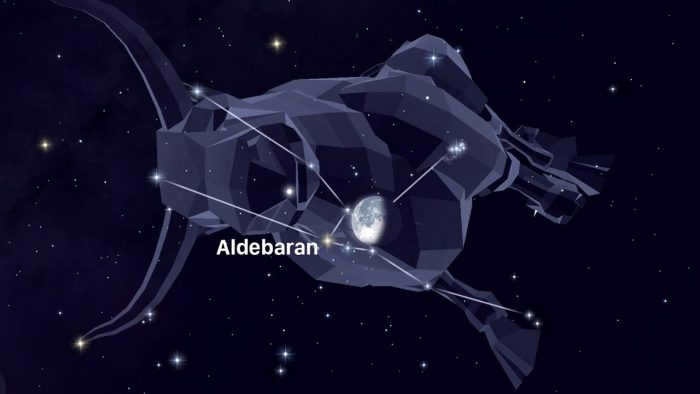
Using specialized techniques, astronomers have discovered that the planet is accompanied by a red dwarf (Aldebaran B), which falls into the M2 class. Its brightness is 13.6 in apparent magnitude and 11.98 in absolute magnitude. It is situated at a distance of 607 astronomical units from Alpha Taurus.
This discovery allows scientists to view both planets as more than just optical companions; they are now seen as representatives of a binary star system. Similar to objects C and D, which are connected through gravitational forces, Aldebaran and its planet only interact visually and are located outside of the planet within the Hyades cluster.
Astronomers have reached the conclusion that there is a substellar object present based on their measurements of the radial velocity of three planets (Pollux, Arcturus, and Aldebaran). The long-period oscillations of these planets have been interpreted as evidence of a gas giant orbiting Alpha Taurus. However, there is still no official confirmation of the existence of this brown dwarf.
In 2015, astronomers observed the presence of a hot giant around Aldebaran Ab, the main component. Its mass is estimated to be 6.47 times that of Jupiter. The satellite orbits the exoplanet every 629 days.
Comparing the Brightness of Stars
When Alpha Taurus began to burn helium, it experienced a significant increase in size, which had an impact on its brightness and made it highly visible from Earth. In the northern hemisphere of the sky, this star ranks 14th in terms of apparent brightness. Aldebaran has an absolute stellar magnitude equivalent to only 150 times that of the Sun, making it the second brightest after Alpha Scorpius. On the other hand, Antares surpasses the Sun’s luminosity by a staggering 4,000 times.
Among the brighter objects in Orion’s belt are Betelgeuse (α) with a brightness reaching 80,000 times that of the Sun, and Rigel (β) with a brightness reaching 45,000 times that of the Sun. However, the largest star is found in the Magellanic Cloud and is known as the Goldfish. Its absolute luminosity exceeds that of the Sun by a staggering 600,000 times.
Aldebaran. The Birthplace of the Aryan Civilization
The origins of the Aryan race can be traced back to a significant event that took place in 1924 – a seance. During this seance, Maria Orsic attempted to establish a connection with the spirit of Dietrich Eckhart, a renowned German anti-Semitic folk poet, playwright, journalist, publicist, and political activist who had passed away. Surprisingly, Orsic claimed to have successfully made contact with Eckhart’s spirit, even speaking in his voice. Eckhart’s spirit had an unusual request – to communicate with an unidentified entity.
Following Eckhart’s request, Orsic started sharing peculiar information that she claimed originated from this unknown entity. According to this entity, the ancient Sumerians were not merely a historical civilization but actually an extraterrestrial race. They originated from a planet located near the star Aldebaran and are believed to be direct ancestors of the Aryans. These alien beings allegedly arrived on Earth an astounding 500 million years ago…
Orsic subsequently asserted that during the session, extraterrestrial beings transferred into her mind the blueprints for a spacecraft with the ability to perform “interdimensional jumps.” She was then able to transcribe these plans onto paper, and according to her claims, the spaceship was actually constructed!
The psychic individual alleged that in 1943, a gathering occurred between the Vril and Thule societies. The purpose of this assembly was to discuss the logistics of an expedition to the Aldebaran system. The objective of the meeting was to determine which individuals would journey beyond our world to make contact with their ancestors.
They departed
Nevertheless, their plans took an unexpected turn. This was because the Vril society had concerns that the SS had infiltrated their organization. Consequently, the Vril leaders were unwilling to let the spaceship fall into the hands of the Third Reich. As a result, they either concealed or destroyed the ship along with all its blueprints. Subsequently, the Vril Society disbanded…
Following this, its members vanished without a trace, leaving behind only speculation regarding their utilization of the ship they had created, possibly journeying to the Aldebaran system.
However, it is alleged that the SS managed to acquire some of the extraterrestrial blueprints, incorporating them into their research on UFO technology…
We are left to ponder if this extraordinary account is factual, or merely another peculiar legend tied to the endeavors of the Nazis.
Aldebaran in literature and other media
- In Kir Bulychov’s literary works, the Aldebaran system is home to a highly advanced civilization. The Aldebarans have shared many of their technological advancements with humans. Their physical appearance is humanoid, with the exception of their knees being located at the back and their elbows at the front. In addition to the native inhabitants, the planets of the Aldebaran system also host representatives from various other civilizations, including humans. In the story “Alice’s Journey” and the animated film “The Mystery of the Third Planet,” a grandmother sends a cake to her grandson Kolya from Aldebaran. Furthermore, in the 24th century, the great-great-granddaughter of Alice Seleznyova (from the story “Napoleon’s Treasure”) will reside on Aldebaran. The planet is also home to a kennel of star dogs, as depicted in the story “Alice and the Enchanted King.” Lastly, the eighth uninhabited satellite of the Aldebaran system’s main planet is known to have walking and sound-making bushes.
- Aldebaran in the works of Stanislav Lem In Stanislav Lem’s writings, specifically in the cycle “The Adventures of Ion the Silent” (specifically, the story “Journey Twenty-Eighth”), there is a star system that is capable of sustaining life. However, the civilization inhabiting this star system is not as advanced as Earth’s when it comes to rocket science. Interestingly, there is mention of the United Aldebaran Shipyards, a group that has named their first edible three-stage rocket (Appetizers-Fried-Desserts) after Aristarchus Felix Tycho, who happens to be Ion Tycho’s cousin.
- In the game Starmageddon 2, the main character finds themselves in the Taurus constellation near Aldebaran when they enter a hyperspace portal. Unfortunately, as soon as they arrive, they are immediately attacked by the Aldebarans.
Curious Information
The colossal star has a staggering age of 6.5 billion years. Researchers have discovered that its radius is a whopping 43 times greater than that of the Sun. Moreover, it boasts a mass 2.5 times that of our very own Sun.
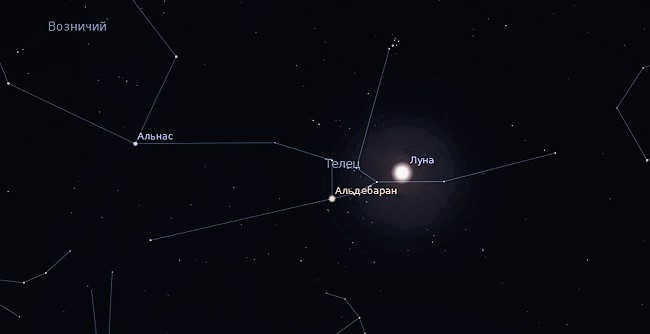
It is worth noting that Aldebaran is also more luminous than our own star. To be precise, it is 150 times brighter. According to astronomical data, Aldebaran ranks 14th in terms of apparent brightness among all the stars.
Astronomers have observed that the Moon sometimes passes in front of the star Aldebaran. Interestingly, this phenomenon can even be witnessed during daylight hours.
There is a possibility that a large planet revolves around this star. However, this theory has not yet been substantiated.
Stars are objects of reverence for priests and subjects of poetic songs. Scientists, on the other hand, study the trajectories, magnitudes, and quantities of stars, leading to important discoveries.
Don’t forget to subscribe to the UFO WORLD Telegram Channel!
Receive instant alerts on your smartphone regarding new Articles
Indeed, Aldebaran has been in existence for billions of years. Over this extensive timeframe, the former red planet has undergone a transformation in its spectral appearance, now possessing an orange hue (classified as K5III) and being classified as a normal giant. The star exhibits minimal fluctuations in brightness, indicating its relative stability.
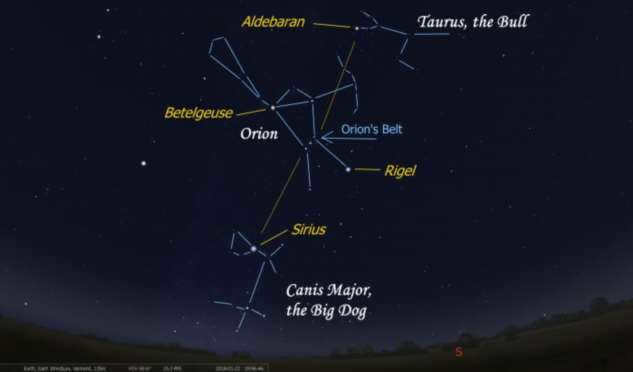
Throughout its centuries-long existence, the planet has managed to consume all of its hydrogen reserves in its core and has now transitioned to burning helium.
These transformations have resulted in an expansion of the celestial body’s size and an increase in temperature, causing a change in the star’s appearance. The outermost layer of the star (as per the most recent data) has expanded to 38 times the diameter of the Sun.
In a few more epochs, the helium in the star’s atmosphere will be depleted, causing the planet to transform into a white dwarf.
At present, Aldebaran is a supergiant star with a diameter 44 times greater than that of the Sun.
The planet’s visibility can be attributed to its relatively short distance from Earth – only 65 light years away.
Actually, the appearance is deceptive. If the stars of the Hyades are gravitationally attracted to each other, then Aldebaran is a solitary star that appears to be part of the cluster. The nearest neighbors to Aldebaran are located 20 light-years away.
This visual deception is also supported by cosmic distances. Aldebaran is twice as close to us as the Hyades cluster. The distance from Earth to the star cluster is approximately 135 light years.
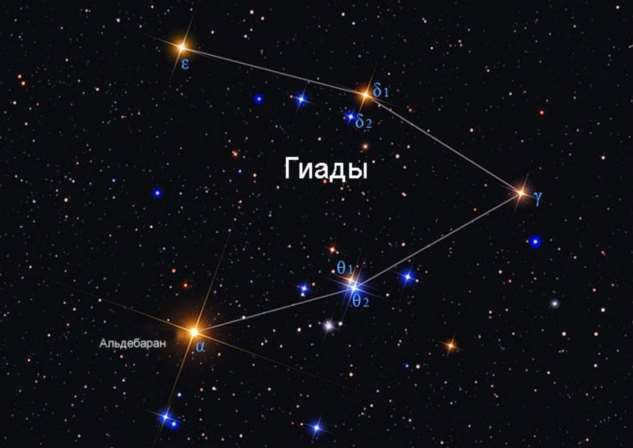
Origin and Significance of the Name
The name Aldebaran has its roots in Arabic. It holds the meaning of “follower”. This name was given to the star in ancient times, but it was officially recognized by the International Astronomical Union in 2016.
When gazing at the night sky, one can’t help but notice that this celestial body appears to be consistently trailing behind the Pleiades cluster. Other ancient civilizations referred to Aldebaran as the Eye and Heart of the Bull, the Torch, the Eye of God, and the Star of Illumination.
Astrological Significance
Aldebaran serves as the left eye of Taurus, representing abundance and prosperity. The right eye of Taurus remains unseen from our perspective and symbolizes the spiritual aspect of humanity. Aldebaran is often referred to as the Protector of the East, embodying strength and determination in achieving one’s desires. With its vibrant scarlet hue, Aldebaran harnesses the force of Mars. The alignment of Aldebaran with the planets in one’s horoscope holds great significance, as does the positioning of the other esteemed Royal Stars.
Aldebaran has the ability to grant wealth, but it is crucial to be cautious of a potential pitfall that may be challenging to avoid. When striving for success and riches, it is easy to overlook the well-being of your soul. Being situated in the Taurus constellation, Aldebaran’s theme revolves around the journey through material possessions, conquering temptations, and seeking self-discovery. This star holds significance in both individual birth charts and national horoscopes. Its primary symbolism is associated with birth and new beginnings.
Aldebaran embodies a potent energy of allure and charisma. Individuals with a strong presence of this star in their horoscope possess magnetic qualities and the ability to draw others towards them. Aldebaran instills determination, enabling one to achieve their desired objective at any cost.
The Origin of the Name
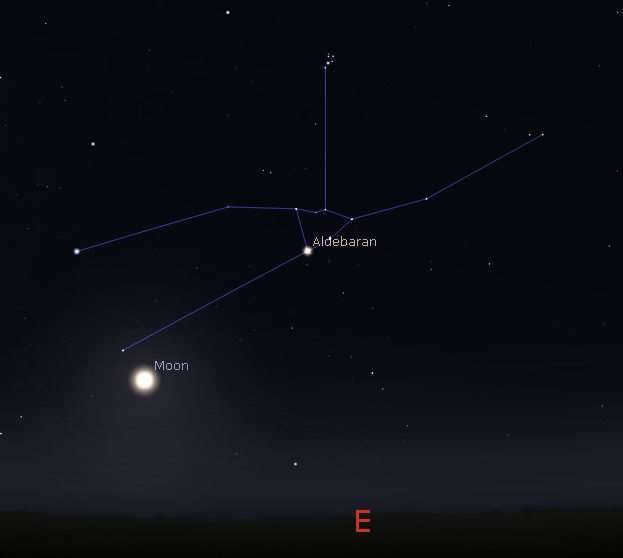
The star Aldebaran is mentioned in ancient texts from various civilizations, resulting in it having multiple names. The Greeks referred to this bright celestial object as “Lamparus,” which translates to “lighthouse” or “torch.” This name reflects the planet’s luminosity in a dark sky, a characteristic that caught the attention of Claudius Ptolemy.
The Romans, on the other hand, named the star “Palicium” in honor of the equinox festival of Pales. The Persians called it the “Royal Star” or “Tusketeer,” while the ancient Chinese referred to it as the “Heart of the Bull.”
Due to its position in the constellation, Aldebaran is often referred to as the “Eye of the Wolf.” In the East, it is also known as the “God’s Eye” and the “Buddha’s Star.”
In Bulgarian culture, the people have associated Aldebaran with the star cluster called “Chorovod” and the bright planet is named “Bagpiper”, rather than being associated with Taurus and the Hyades cluster.
The origin of the name, which is recognized by scientists as an official name, can be traced back to Arabic roots. Translated, it means “follower”, as it follows the Pleiades. The Pleiades are a scattered cluster in the sky, with only 7 stars visible to the naked eye.
In the early 17th century, Aldebaran was given the letter designation of “Alpha Taurus” by Johann Bayer, a German astronomer, in his stellar treatise “Uranometria”. This designation solidified Aldebaran as the brightest planet in the Taurus constellation.
To which constellation does Aldebaran belong?
Aldebaran actually belongs to the constellation Taurus. It is the Alpha star in this part of the sky. Furthermore, it is one of the brightest stars in the zodiac and possibly the entire sky. The name Aldebaran is derived from Arabic and means “follower,” likely because it appears to trail behind the Pleiades. It is also often referred to as the Eye of Taurus due to its resemblance to a bull’s eye. Additionally, it is known by other names such as Palilius or Lamparus.

Physical characteristics of the orange giant star
The star’s physical description provides valuable information for scientific registries. The orange giant star is classified as K5 III according to its spectral class. The table below presents the main parameters of α Taurus.
Physical characteristics of α Taurus
| Parameters | Unit. | Indicator (average) |
| Mass of the star | M☉* | 2.5 |
| Radius | R☉ | 43 |
| Age | billion years | 6.6±2.4 |
| Metallicity** | % | 70 |
| Temperature | K | 3875±3050 |
| Luminosity | L☉ | 150 |
*Luminosity is a measurement unit outside of our solar system that calculates the characteristics of stars in relation to the Sun (M, R, L).
**This term describes the presence of chemical elements on a planet that are heavier than helium and hydrogen by weight. The measurement is given as a percentage of the solar parameter.
Astrometry also considers the measurement of parallax. This measurement determines the angle of change in the position of an object in relation to the observer’s location. For Aldebaran, this measurement is 50.09 mas (milliseconds) and allows for precise determination of the star’s distance. The radial velocity of the planet falls within 53.8 km/s.
It is a binary star
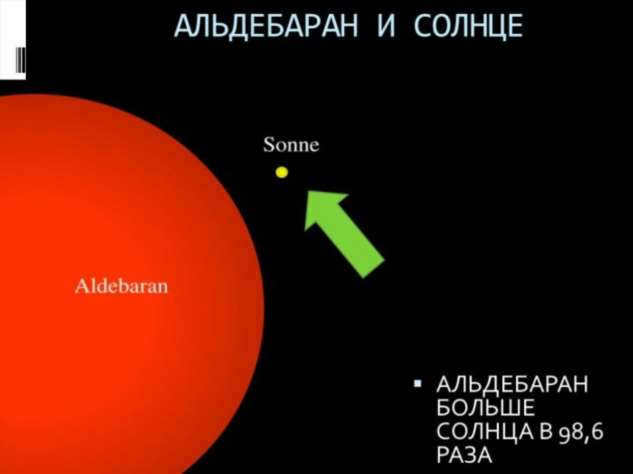
Comparison of the sizes of the Sun and AldebaranAldebaran is an orange giant star that exhibits a slight variation in brightness due to ongoing processes, leading to its classification as an irregular variable star.
The size of this star is larger than our sun. Its radius is 43 times larger and its mass is 2.5 times heavier. It also has a luminosity that is 150 times greater than the solar luminosity, which places it in fourteenth place in terms of apparent brilliance. The temperature of this star reaches 4000 K and it is located 65 light-years away from us. It will take the Pioneer 10 drone, which was launched in 1972, two million years to reach this star. This just goes to show the immense scale of the universe. The companion star, Aldebaran B, is located a few hundred astronomical units away. It is a red dwarf star with a radius and mass that are about 0.44 times that of our sun. It has a luminosity of 0.035 and a temperature of about 3600 K. Stars of this class are still not well understood.

Distinctive qualities of the star Aldebaran
Locating the star
The ideal time to observe Aldebaran is during the winter and spring seasons. To easily locate it, look for the three stars that make up Orion’s belt, then draw a straight line to the right, where you will come across the brightest star, which is Aldebaran. Aldebaran serves as the alpha star in the Taurus zodiac constellation. Within this constellation, you will find two distinct clusters, namely the Pleiades and the Hyades. When observing from Earth, it may appear that Aldebaran is part of the Hyades cluster, as its bright stars form a V shape. However, this is merely an optical illusion, as the cluster is actually located 153 light years away, significantly farther than Aldebaran.
Visual companions
There are five faint stars visible near Aldebaran in the sky. These stars are part of a binary star system and have been named using capital letters of the Latin alphabet, in the order of their discovery. The primary star in the system is designated as star A. The table below provides information about the position of these companion stars in relation to Aldebaran.
According to the Gaia Data Release 2, there is evidence suggesting that Alpha Taurus B and Aldebaran have similar proper motion and parallax, indicating that they may form a binary system. However, determining this association is challenging due to the close proximity of the faint B component to the bright host star, resulting in a large margin of error. As a result, it has not been definitively established whether the B component or any other object is physically connected to Aldebaran. The B component has been assigned a spectral class of M2.5.
The CD system of Alpha Tauri consists of two stars, C and D, that are gravitationally linked and revolve around each other. These stars, which share the same orbit, have been observed to be located far from Aldebaran and are part of the Hyades star cluster. Similar to the other stars in the cluster, they have no direct physical interaction with Aldebaran.
In 1993, the radial velocity measurements of Aldebaran, Arcturus, and Pollux indicated that Aldebaran displays fluctuations in its radial velocity over long periods of time, which could potentially be attributed to the presence of a substellar companion. The measurements for Aldebaran suggested that it has a companion with a minimum mass of 11.4 times that of Jupiter, orbiting at a distance of 2.0 a.u. (300 Gm) in a slightly eccentric orbit lasting for 643 days. However, all three stars examined exhibited similar oscillations and had similar companion masses, leading the authors to conclude that the observed changes were likely intrinsic to the stars themselves rather than being a result of the gravitational influence of a companion.
The study conducted in 2015 provided consistent and lasting proof of the existence of both a planetary companion and stellar activity. Through asteroseismic analysis of the remains of the planet’s accumulation, it was determined that Aldebaran b has a minimum mass of 5.8 ± 0.7 Jupiter masses. Additionally, when the star was in its main sequence, it emitted light levels similar to those of Earth, indicating a potentially suitable temperature. This suggests that both the planet and its satellites could be located in the habitable zone.
Etymology and mythology
Originally known as نير الضبران (Nā᾽ir al Dabarān in Arabic), Aldebaran derives its name from the phrase “bright of the follower”. The term al Dabarān (الدبران) was initially used to refer to the entire lunar mansion that housed the Hyades. It is believed that Aldebaran was positioned in the sky following the Pleiades. Over time, various transliterations have been employed, with the current Aldebaran being a more recent standard.
Mythology
This star, with its distinctive constellation, is well-known and has been the inspiration for numerous ancient and contemporary myths.
- Mexican culture: According to the seris of northwestern Mexico, this star illuminates the seven women in labor (known as the Pleiades). It is referred to by three names: Hant Caalajc Ipápjö, Queeto, and Azoj Yeen oo Caap (“the star that goes ahead”). The lunar month corresponding to October is called Queeto yaao, meaning “the way of Aldebaran.”
- Aboriginal culture: In the Clarence River region of northeastern New South Wales, this star is considered the ancestor of Carambal, who eloped with another man’s wife. The woman’s husband eventually found them and set fire to the tree they were hiding in. It is believed that Carambal ascended into the sky as smoke and became the star Aldebaran.
- In Hindu astrology, it is known as the celestial abode of Rohini (“crimson”) and as one of the twenty-seven daughters of Daksha and the spouse of the deity Chandra (Moon).
- In ancient Greek, it was referred to as Λαμπαδίας Lampadias, literally meaning “torch, like a bearer of torches”.
- In Chinese, 畢宿 (B.I. Xiu), which means “grid”, refers to the group of stars consisting of Aldebaran, e taurus, taurus3δ, taurus1δ, γ taurus, 71 taurus, and λ taurus. Therefore, the Chinese name for Aldebaran itself is 畢 宿 五 (Bì Xiù wǔ), meaning “the Fifth Star of the Set”.
In contemporary society.
The appellation Aldebaran or Alpha Tauri has been embraced on numerous occasions, encompassing.
Aldebaran (AF-10) and the Italian frigate (F 590)Aldebaran
- Aldebaran’s proposed microsatellite launcher
- French corporation Aldebaran Robotics
- fashion brand AlphaTauri
- Formula 1 team Scuderia AlphaTauri , formerly known as Toro Rosso.
The star also makes appearances in works of fiction such as “Away from the Madding Crowd” (1874) and “Down and Out in Paris and London” (1933). It is frequently depicted in science fiction, including the TV series “The Lensman” (1948-1954) and “Fallen Dragon” (2001). As the most brilliant star in the constellation of the Zodiac, it is also bestowed with significant significance in astrology.
Aldebaran is frequently mentioned in various conspiracy theories as one of the potential sources of extraterrestrial beings, often linked to Nazi UFOs. A notable example is the German conspiracy theorist Axel Stoll, who believed that this star served as the dwelling place for the Aryan race and was the objective of Wehrmacht expeditions.
The Pioneer 10 planetary research probe is no longer operational or in communication with Earth, but its path is currently leading it towards the general vicinity of Aldebaran. It is projected to approach this star in approximately two million years.
Within African folklore, Aldebaran is regarded as the hunter and the spouse of the Pleiades. On one occasion, he asked his wife to capture a zebra, and if she failed to do so, he insisted that she not return home. Aldebaran embarked on the hunt, but he only brought along a single arrow. Unfortunately, luck was not on his side, and the arrow missed its target. Ever since that incident, he has been following the Pleiades, fearful of returning home.

Check out this video on YouTube
Spotting the celestial body
So, we have determined the location of Aldebaran within a specific constellation. Furthermore, it holds the distinction of being the most brilliant zodiacal constellation. Hence, locating it in the night sky should not present any difficulties. Let’s explore how to pinpoint its position.
- Firstly, it is important to note that winter is the optimal time for this endeavor. However, caution must be exercised. For instance, in the month of December, a more luminous and larger planet traverses through Taurus. As a result, Aldebaran is frequently mistaken for Jupiter.
- Secondly, to locate the constellation, one must initially locate Orion. Following that, draw an imaginary straight line extending to the right. This line will ultimately lead to a radiant celestial object. That is none other than Aldebaran itself.
Position in the celestial sphere
The zodiacal constellation reaches its highest point above the horizon between the months of November and January. During this period, the distinct shape of Taurus becomes clearly visible, with the most prominent feature being the blood-red eye of the “angry” Bull known as Aldebaran. The animal’s horns are formed by a series of less bright stars.
The eye of the crow seamlessly fits into the “head” region, which is outlined by the Hyades cluster. Furthermore, the starry Pleiades cluster appears to be perched on the back of Taurus.
By knowing the constellation to which Pallium belongs, it becomes easier to locate its position in the sky. It is advisable to start the search from familiar reference points. Simply gazing at the evening sky and locating the Big Dipper’s handle can serve as an excellent starting point, as Taurus is a non-setting constellation.
Depending on the season, the position of the Bucket changes. During winter, it is visible in the northeast, while in the fall and summer it can be seen in the north. The next step is to locate the outermost stars of the Bucket and connect them with a straight line.
If you continue the line upwards, you will come across the first bright star, known as Polaris. This star helps to define the Little Bear constellation. The second constellation is useful for easily navigating the directions. Polaris, along with its small dipper, is located to the north of the Big Dipper.

It will only be possible to search further in the autumn-winter period when the Taurus constellation is clearly visible in the Northern Hemisphere sky. The next steps can be represented by the following algorithm:
- At around 20 hours in the winter sky, easily locate the Big Dipper and take note of the 4 corner points of the constellation;
- Mentally draw a straight line to the east from the lower right star of the Big Dipper, known as Merak;
- Continue past Gemini towards the brightest star, Betelgeuse;
- Here you will find a group of planets forming the constellation Orion; the figure of the “hunter” consists of 7 stars arranged symmetrically, and they can be clearly seen in the night sky;
- One notable landmark could be the Pleiades, which are occasionally confused with the Little Bear’s Bucket. The cluster is situated just above the Taurus constellation. To enhance the effectiveness of the planet search, it would be helpful to possess an image of the celestial dome. Additionally, when determining the whereabouts of the star Aldebaran in the heavens, utilizing a map is advisable.
When to observe
The specific time for observing Alpha Bull is determined at 04 h 35 m 55.2 s, with a declination of +16°30´33″. However, these coordinates are better understood by experts. In the evening, it is easily noticeable how Orion’s Belt and Aldebaran rise almost simultaneously in the east.
This star becomes visible in the winter sky shortly after sunset, and it remains brightly shining throughout the night. By March, Alpha Taurus is already positioned high in the sky during sunset and disappears behind the horizon after midnight.
Therefore, it is recommended to observe this star during the winter season. However, it is important to note that in December, Jupiter appears in the Taurus constellation, which is much brighter than the “Cow’s Eye”. Aldebaran becomes less visible in comparison, which can be confusing for observers.
Sometimes, you may witness the Moon eclipsing the Eye of God. The phenomenon was last observed in the daytime sky in August 2017.
Meteorology
Meteorologists have observed that Alpha Taurus influences the climate on Earth. When Aldebaran rises together with the Sun, expect foggy, windy weather with rain and thunderstorms.
When it appears alongside Mars, it brings restlessness to nature, provoking hurricanes, and during the summer season, it brings intense heat.
Satellites of Aldebaran
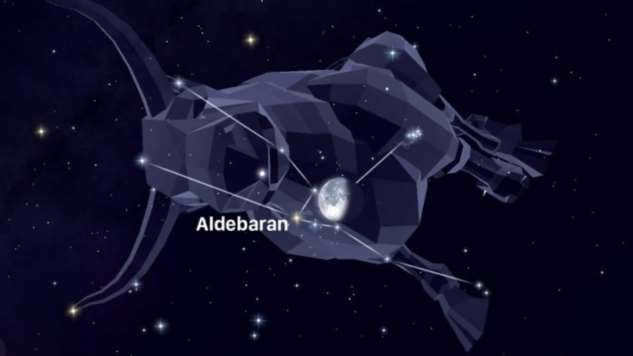
Astronomers have discovered that the planet has a companion in the form of a red dwarf (Aldebaran B), which falls under the M2 classification. Its apparent magnitude is 13.6, while its absolute magnitude is 11.98. Aldebaran B is situated at a distance of 607 astronomical units from Alpha Taurus.
This finding suggests that both the planet and the red dwarf are not simply optical companions, but rather part of a binary star system. They are similar to objects C and D, which are gravitationally bound together. However, Aldebaran and its companion only interact visually, as they are located outside the planet within the Hyades cluster.
In 2015, astronomers made a discovery about the main component of Aldebaran, known as Aldebaran Ab. They found that it has a hot giant exoplanet orbiting around it, with a mass that is about 6.47 times larger than Jupiter. This exoplanet completes one orbit around Aldebaran Ab in approximately 629 days.
Moving on to the topic of comparing the luminosity of stars, Alpha Taurus, also known as Aldebaran, experienced a significant increase in size as it began to burn helium. This increase in size had a direct impact on its brightness, making it one of the most visible stars from Earth. In terms of apparent luminosity, Aldebaran ranks 14th in the northern sky hemisphere. Its absolute stellar magnitude is only 150 Suns, second only to Alpha Scorpius. In comparison, Antares has a luminosity that is 4,000 times greater than that of the Sun.
In the vicinity of Aldebaran, there are other bright objects in the constellation Orion’s belt. Betelgeuse (α) has a luminosity that is equivalent to 80,000 Suns, while Rigel (β) has a luminosity of 45,000 Suns. However, the largest star in terms of absolute luminosity is the Goldfish in the Magellanic Cloud, which exceeds the solar luminosity by 600,000 times.
Earth-based observers utilize the concept of “apparent brightness”. Unlike absolute brightness, it is contingent upon the planet’s distance. Even Hipparchus used the luminosity of Vega (α Lyrae) as a reference point – its stellar brightness is indicated by 0 m. However, it does not hold the top spot. As a result, objects that are brighter have a negative value.
Aldebaran. The Birthplace of the Aryan Race
The origins of this story can be traced back to a séance held in 1924, where Orsich attempted to establish contact with the spirit of Dietrich Eckart, a deceased German anti-Semitic folk poet, playwright, journalist, publicist, and political activist. It is said that Orsich successfully made contact with Eckart’s spirit and even began speaking in his voice, relaying a rather peculiar tale. According to the spirit, they were merely a vessel through which an unknown entity wished to communicate.
What followed were a series of bizarre revelations. The unidentified entity claimed that the ancient Sumerians were not of this world, but rather an extraterrestrial race hailing from a planet near the star Aldebaran. Furthermore, they asserted that these aliens were the direct progenitors of the Aryan race, arriving on Earth a staggering 500 million years ago…..
Later, Orsic made the assertion that during the session, the extraterrestrials downloaded the blueprints for a spacecraft capable of making “interdimensional jumps” directly into her mind. Remarkably, she was able to transcribe these plans onto paper, and it is even rumored that the spacecraft was successfully constructed!
The psychic medium went on to claim that a meeting took place in 1943 between members of the Vril and Thule societies. The purpose of this gathering was to discuss the logistics of a journey to the Aldebaran system. The attendees of this meeting had the task of determining who would venture beyond our world to make contact with their ancient ancestors.
They Departed
However, the course of events did not unfold as planned. This was due to concerns within the Vril society that the SS had managed to infiltrate their ranks. The leaders of the Vril society were adamant about preventing the spaceship from falling into the hands of the Third Reich. Consequently, they either concealed or destroyed the ship along with all its blueprints. Subsequently, the Vril Society disbanded…
Following the dissolution of the society, its members mysteriously vanished without a trace, leaving behind only speculation that they utilized the ship they had constructed and journeyed to the Aldebaran system.
Nevertheless, it is rumored that the SS managed to recover certain extraterrestrial blueprints, which they then utilized in their research on UFO technology…
We are left to contemplate the veracity of this remarkable tale and whether it is merely one of the many peculiar legends associated with Nazi activities.
- In the Stanislaw Lem’s works, specifically in the “The Adventures of Ion the Silent” series (story “Journey Twenty-Eighth”), Aldebaran is depicted as a star system that is capable of supporting life. However, the civilization inhabiting it is not as advanced as Earth’s when it comes to rocket science. The story mentions the United Aldebaran Shipyards, which have named their first edible three-stage rocket (Appetizers-Fried-Desserts) after Aristarchus Felix Tycho, who is Ion Tycho’s cousin.
- In the Starmageddon 2 game, the main character ventures into the Taurus constellation near Aldebaran by using a hyperspace portal, only to be immediately confronted by aggressive Aldebarans.
Did you know?
It’s absolutely fascinating to learn that the gigantic star has been in existence for an astonishing 6.5 billion years! Incredibly, scientists have discovered that its radius is a whopping 43 times larger than the radius of our own Sun. Not only that, this colossal star is also a staggering 2.5 times more massive than our Sun. Truly mind-blowing!
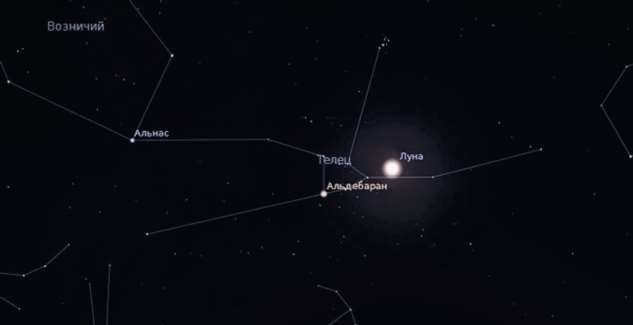
It is worth noting that Aldebaran is also brighter than our Sun. To be more precise, it is 150 times brighter. According to astronomical data, Aldebaran is ranked 14th in the list of stars based on its apparent brilliance.
According to astronomers, there are instances when the Moon covers Aldebaran. Interestingly, this phenomenon can be observed even during the daytime.
There is a possibility that there is a large planet orbiting around this star. However, further evidence is required to confirm this.
Stars hold a significant place in various aspects of human culture. They are prayed to by priests and sung about by poets. Scientists dedicate their studies to analyzing the paths, magnitudes, and numbers of stars, leading to important discoveries.
Aldebaran, also known as Alpha Taurus or the Eye of Taurus, is an orange giant located 65 light years away. It is the brightest star in the Taurus constellation and ranks 14th in the night sky. In terms of luminosity, it is 518 times more radiant than the Sun.
The term “al-dabarān” is derived from the Arabic language, meaning “follower”. This celestial body belongs to the K5 III classification and has an apparent magnitude ranging from 0.75 to 0.95. It is categorized as an irregular LB variable star and is identified as CSV 6116 in the compilation of dubious variables.
Aldebaran has already exhausted the hydrogen fuel in its core and is currently fusing it in the surrounding envelope. As a result, it has become significantly brighter and expanded to a radius 44.2 times larger than that of the sun. The image below depicts the reddish hue of the star Aldebaran.

If Aldebaran were placed at the center of the solar system, it would occupy about half of Mercury’s orbital path. Its mass is 1.7 times that of the Sun. In a few million years, it is expected to become 800 times brighter than the Sun. Eventually, most of its mass will escape into space and form a planetary nebula, leaving behind a white dwarf.
In terms of temperature, Aldebaran is only heated to 4000 K, while the Sun has a temperature of 5800 K. It takes Aldebaran 643 days to complete one revolution.
Comparison of the sizes of Aldebaran and the Sun
Stellar system
Within close proximity, there exist an additional 5 dim stars, although several of them merely serve as companions. They have been designated as B through F in accordance with their respective positions. Aldebaran A stands as the primary star.
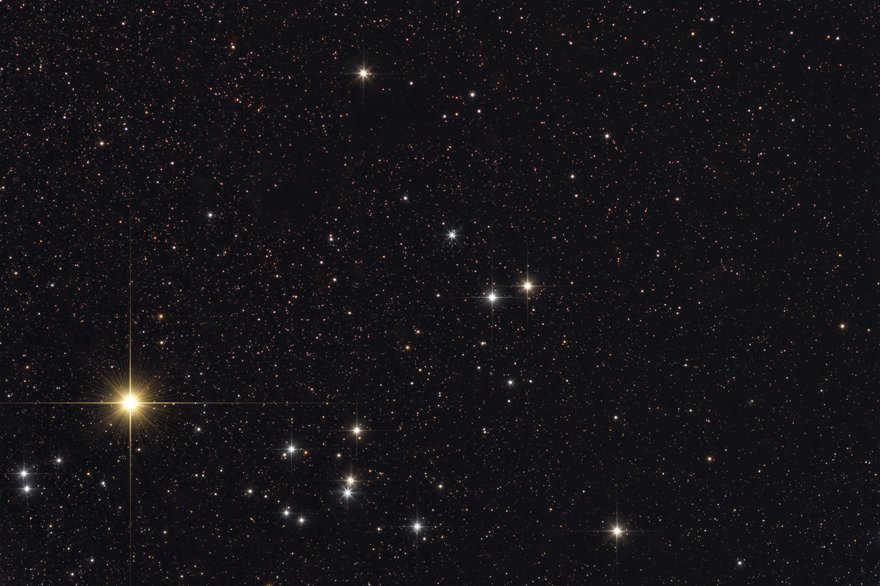
The star Aldebaran (bottom left) and the Hyades star cluster
Aldebaran B, with an apparent magnitude of 13.6 and an absolute magnitude of 11.98, is a red dwarf (M2V) located 607 astronomical units away from the host star. According to reviews, it is possible that these two stars are not just optical companions, but actually form a physical double star system.
Stars C and D, which are K5 and M2 dwarf and subdwarf stars respectively, are gravitationally bound and create a double star system. They are located 34 astronomical units away from Aldebaran A and are part of the Hyades cluster.
Interesting Information
Aldebaran serves as the right eye of the constellation Taurus, while Epsilon Taurus serves as the left eye. Positioned alongside the Hyades cluster, Aldebaran stands out as the most brilliant member of this celestial group. The cluster itself takes the form of a V and bears a striking resemblance to the head of a bull. Situated approximately 150 light-years away from our location, it offers a captivating sight in the night sky.

Back in July of 1997, Aldebaran made its appearance just before dawn.
Alpha Taurus, being in close proximity to the ecliptic, is often obscured by the Moon. On June 1st of each year, it aligns with the Sun. In the 1990s, scientists reported the possible existence of a companion star, but subsequent observations failed to confirm this. If such a star does exist, it would have a mass 11.4 times that of Jupiter, be located at a distance of 2 astronomical units, and have an orbital period of 643 days.
Aldebaran, which hails from the Taurus constellation, is renowned for being one of the brightest stars in the near-infrared spectrum. It boasts a magnitude of -2.1, placing it second only to Betelgeuse, R Goldfish, and Arcturus.

Different cultures have given different names to the star. The Persians referred to it as Tusketeer, the Eastern Royal Star. It was also known as the Star of Buddha, the Eye of God, and the Star of Illumination.
About 5,000 years ago, its appearance marked the vernal equinox and the start of the year in Babylon. The Romans called it Palilicium, in honor of the feast of Pales (the female form of Pan). The Chinese named it the Fifth Star Seti, and during the Middle Ages, it was referred to as the Heart of the Bull.
In Hindu mythology, the star Aldebaran was known as Rohini, one of Daksha’s 27 daughters. The moon god became infatuated with her and spent more time with her than his other wives. This angered Daksha, who cursed him. As a result, the moon god was fated to suffer from tuberculosis for 15 days, followed by 15 days of recovery, which explains the lunar phases.
The people of Mexico believed that the star provided light for seven women in labor, also known as the Pleiades. The Dakota Sioux believed that Aldebaran fell to Earth and slayed a serpent, giving birth to the Mississippi River.
Aldebaran has been mentioned in various works of literature, including Lee Brackett’s “Stammen,” Joe Haldeman’s “Forever War,” Kim Robinson’s “Blue Mars,” and Eduardo de Oliveira’s comic book series. There are also references to Aldebaran in episodes of Star Trek.
Aldebaran can also be found in literary works that are far from the realm of science fiction, such as James Joyce’s “Ulysses,” George Orwell’s “Down and Out,” and Tolkien’s “The Lord of the Rings.”
Physical characteristics and orbit
- Constellation: Taurus.
- Spectral Class: K5 III.
- Coordinates: 04h 35m 55.239c (right ascension), + 16° 30' 33.49" (declination).
- Distance: 65.1 light-years.
- Visible magnitude (V): 0.75-0.95.
- Apparent magnitude (J): -2.10.
- Absolute magnitude: -0.63.
- Variable type: LB.
- Mass: 1.7 times that of the Sun.
- Radius: 44.2 times that of the Sun.
- Luminosity: 518 times that of the Sun.
- Temperature: 3910 K.
- Rotation period: 643 days.





